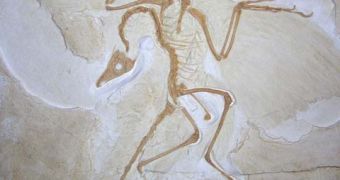Fossilized dinosaurs can be found in the most bizarre postures, like mouth wide-open, head thrown back and recurved tail, like in the case of the 150 million-year-old Archaeopteryx, a feathered dinosaur supposed to be a link between dinosaurs and birds. The classical explanation was that the dinosaurs died in water and the currents positioned the bones that way, or that rigor mortis or drying muscles, tendons and ligaments contorted the body segments.
Now, researchers say that the contorted position is a result of agonized death throes typical of brain damage and asphyxiation.
"I'm reading this in the literature and thinking, "This doesn't make any sense to me as a veterinarian. Paleontologists aren't around sick and dying animals the way a veterinarian is, where you see this posture all the time in disease processes, in strychnine cases, in animals hit by a car or in some sort of extremis." said lead author Cynthia Marshall Faux of the Museum of the Rockies, a veterinarian-turned-paleontologist.
The posture is well known in neurology as opisthotonus and is caused by damage to the brain's cerebellum, occurring in humans and animals due to suffocation, meningitis, tetanus or poisoning and characterizing a long, slow death.
"Some animals found in this posture may have suffocated in an ash fall during a volcanic eruption, consistent with the fact that many fossils are found in ash deposits", signaled the researchers.
"This explanation gives us clues to interpreting a great many fossil horizons we didn't understand before and tells us something dinosaurs experienced while dying, not after dying. Also, because the posture has been seen only in dinosaurs, pterosaurs and mammals, which are known or suspected to have had high metabolic rates, it appears to be a good indicator that the animal was warm blooded. Animals with lower metabolic rates, such as crocodiles and lizards, use less oxygen and so might have been less traumatically affected by hypoxia during death throes", said co-author Kevin Padian, professor of integrative biology and curator in the Museum of Paleontology at the University of California, Berkeley.
Indeed, many dinosaur fossils belonged to animals which died in water and were carried by the current into the arched position, but this cannot explain the opisthotonic cases.
Faux tested rigor mortis, a temporary stiffening of muscles after death and the drying of muscles, tendons and ligaments for inducing the opisthotonic posture.
She made use of corpses of euthanized injured raptors (great horned owls, red-tailed hawks and falcons) from a recovery center and monitored them for rigor mortis, testing them periodically for 8 to 10 hours.
"In horses and smaller animals, rigor mortis sets in within a couple of hours, so I just looked to see if they were moving or not. And they weren't moving. They were staying in whatever position I'd left them in. I thought, 'If birds aren't doing it, and I'd never observed a horse doing it, then why would dinosaurs be doing it?'" said Faux.
She checked the hypothesis of the drying muscles and tendons with two euthanized red-tailed hawks dried for two months in Styrofoam peanuts.
"Most joints have counterbalancing muscles that dry the same way so there was no reason to expect that the muscles would turn a joint during drying." she said.
She detected no post-mortem movement and even when she pinned drying beef tendons, as they shrank, they did not do it enough even to relocate the pins.
"Given these observations, it is hard to imagine how shrinking tendons or muscles could drag a heavy creature into a different position."
"All opisthotonic dinosaurs are very well preserved, meaning they evidently did not sit out in the open for long, or scavengers would have quickly scattered the bones." pointed Padian.
The brain damage seems the only satisfactory explanation.
"The cerebellum is responsible for fine muscle movement, controlling, for example, the body's antigravity muscles that keep the head upright. Once the cerebellum ceases to modulate the behavior of the antigravity muscles, the muscles pull at full force, tipping the head and tail back, contracting the limbs and opening the mouth." said Faux.
The team pointed out Allosaurus, a carnivorous dinosaur, displayed bone lesions similar to bacterial infection that can also cause meningitis, a disease that induces opisthotonus.
"This example and others suggest that reevaluation may be in order for an untold number of paleoenvironments whose story has been at least partly explained on the basis of the death positions of many of their fossil vertebrates," wrote the researchers.

 14 DAY TRIAL //
14 DAY TRIAL //